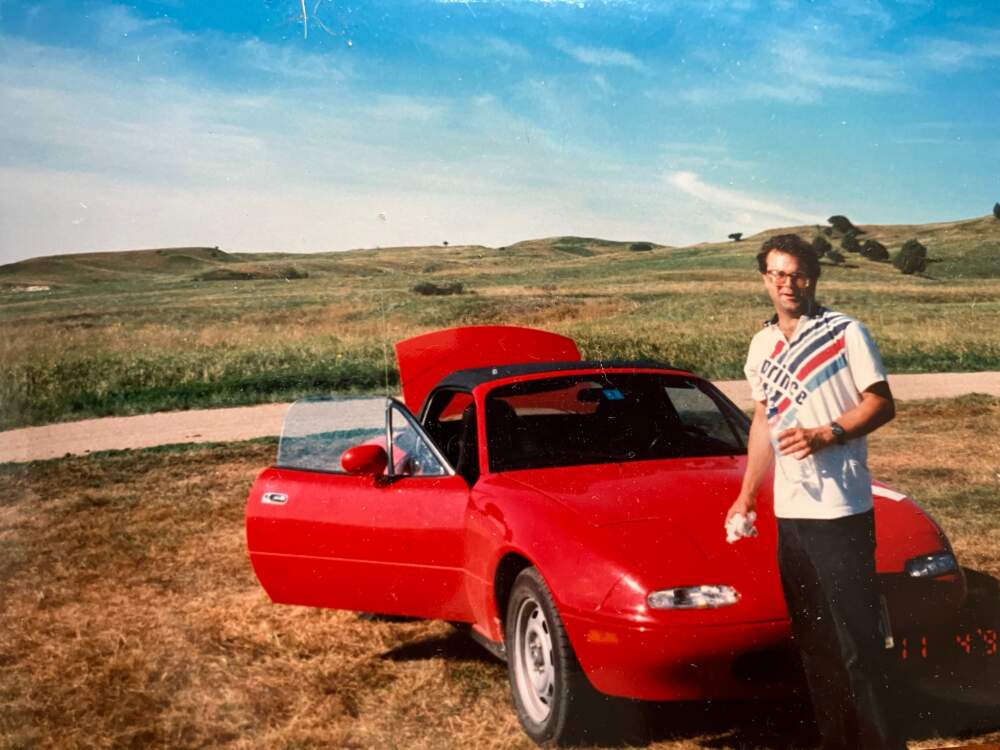Advertisement
Commentary
I drove my Mazda Miata for 13 years. Then life intervened

In 1994, a coworker playfully psychoanalyzed me after I bought a cherry-red Mazda Miata: “You’re young. You’re single. You’re stupid.” (She worried that the tiny two-seater would become my casket, that I’d be flattened by behemoth SUVs.) Her personality triptych omitted key points, though, including my minimalist’s fascination with a car that looked like it’d been shrunken. I also appreciated its fuel efficiency — easy on the wallet and the atmosphere.
Sunday is Miata Day at Brookline’s Larz Anderson Auto Museum. The museum’s devotional to the cult-inspiring roadster reminds me that I’d still own mine, but for the intervention of life. I’m carless today — I take buses and trains for most travel. For me, the journey from Mazda Miata to mass transit is a metaphor for aging and the unforeseeable detours we travel through life.
We are what we drive. And what we don’t drive.
Sports cars stereotypically leaven a midlife crisis, but I was just 35 in 1994. Living in New Hampshire, I’d long coveted a roadster: the low, narrow lines of a vehicle that screamed NOT FOR FAMILY USE. Supposedly sager heads counseled against the lightweight ragtop as impractical on unpaved roads and in New England snow. My late mother, also certain the car was a death box, hung up the phone when I wouldn’t budge.
But one friend, an auto aficionado, encouraged my dream. He told me I could keep the Miata in a garage during the winters, finding an affordable junker for the December-through-March slog. That kind soul also taught me to drive a stick shift, a theretofore magical power I’d never mastered, that was essential to driving a Miata.
Cruising through the White Mountain National Forest, without a car roof between me and the stars, I felt connected to the countless, luminous pinpoints overhead.
I got the car in April. It’s true that it felt as light as a skate while driving, but I found that more exhilarating than frightening. Breezes ruffled hair and cooled skin. “Being one with the universe” remains a mystically unfathomable expression, but the closest I’ve come was a night spin that first summer on New Hampshire’s fabled Kancamagus Highway. Cruising through the White Mountain National Forest, without a car roof between me and the stars, I felt connected to the countless, luminous pinpoints overhead.
In the nation that produced Kerouac, the Constitution practically prohibits owning a car designed for pleasure driving without attempting a cross-country trek. Mine came three years after purchase.
Impressions of that September-long journey marble my memory:
Driving Western expanses with the top down, the overhead blue unbroken by any obstructions on the horizon, visually demonstrating why they call it the “Big Sky.”
Braking for a red light behind a trolley on one of San Francisco’s infamous inclines, then screeeeching forward on green as I fumbled to synchronize hitting the gas and releasing the clutch.
Defying all the doomsayers by making it across the continent and back without a scratch — just one flat tire — only to arrive home, stop for another red light and watch the inattentive doofus in front of us back into my front.
With no other seed money for a 529 account, I sold my metal baby. I never regretted buying a roadster. And I’ve never regretted selling it.
Miatas evolved during the 13 years that I drove one. The pop-up, frog’s-eye headlights on mine gave way to exposed beamers, among other tweaks. My young and stupid self also morphed. I loved that car so much I wanted to be buried in it; then our son was born.
The specter of college put a distant but discernible demand on the finances. With no other seed money for a 529 account, I sold my metal baby. I never regretted buying a roadster. And I’ve never regretted selling it.
We’ve all seen the famous (but inaccurate) chart depicting the ascent from simian primitive to modern human. Similarly, life’s evolution takes many of us from two-seaters, road trips and impromptu nights out to family cars, playdates and college funds. This is called growing up. It brings new pleasures and, yes, new burdens. Either way, it’s as necessary for parents as for their children. And inevitable: You’d have better luck standing upright in a hurricane than fighting it.
The birth of a child who is now a rising college freshman, swapping my roadster for a family car, and then for mass transit during a divorce. All have been part of aging for me.
Others today are what they drive. I am what I don’t drive. And I’m at peace with that.
